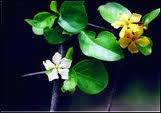| PlantID | 0137 |
| Botanical Name | Xeromphis spinosa |
| Common Name | Arar |
| Classification | | Kingdom: | Plantae | | Subkingdom: | Tracheobionta | | Division: | Magnoliophyta | | Class: | Magnoliopsida | | Subclass: | Asteridae | | Order: | Rubiales | | Family: | Rubiaceae | | Genus: | Xeromphis | | Species: | spinosa |
|
| Part used | Stem, bark and Fruits. |
| Medicinal Properties | Fruits: alexiteric, aphrodisiac, emetic, carminative, antipyretic, purgative and anodyne. Pulp of fruit bark: anthelmintic and abortifacient.
|
| Medicinal Use | Stem bark made into a paste and mixed with goat's milk and country liquour. This is prescribed in rheumatism once daily on an empty stomach. Fruits: cure abscess ulcers, inflammations tumours, skin diseases, pain in muscles, piles, chronic bronchitis, paralysis, leprosy, boils and eruption, brain diseases, asthma, leucoderma and rheumatism. Pulp of fruit bark: bone ache during fever.
|
| Chemistry | Bark: mannitol and six saponins. Hydrolysis of saponins yielded randialic acid B, from a mixture of aglycones, glucose, xylose and rhamnose. Six saponins are - dumetoronins A, B, C, D, E and F - isolated, all of them contained oleanolic acid as aglycone. |
| Cultivation | NA |
| Regional Habitat | Hilly area of Rajasthan. Distribution: Sirohi (Mt. Abu) and Kota districts of Rajasthan.
|
| Description | Armed shrubs/small trees with strong straight, nearly opposite decussate spines, coming off from above the branchlets. Bark: dark brown or black, rough. Branches: rigid, horizontal, many of the lateral ones suppressed and very short. Leaves: usually fascicled, stipules ovate, accuminate; petioles densely pubescent; lamina cuneate at base, elliptic to obovate, veins 6-10 pairs, apex obtuse. Flowers: fragrant, solitary or 2 (rarely 3) together, at the ends of short leaf-bearing branchlets; peduncles short; Calyx - tube broadly campanulate, teeth 5, ovate-oblong, sub-acute, often small intermediate teeth between; Corolla - white, turning yellowish, lobes nearly as broad as long, obovate-oblong, apex obtuse, reflexed. Fruits: globose or broadly ovoid, smooth or obscurely longitudinally ribbed, crowned with large calyx-limb and glabrous. Seeds: many, flat, embedded in pulp. Flowers and fruits appears during March to June.
|
| Image |  |


